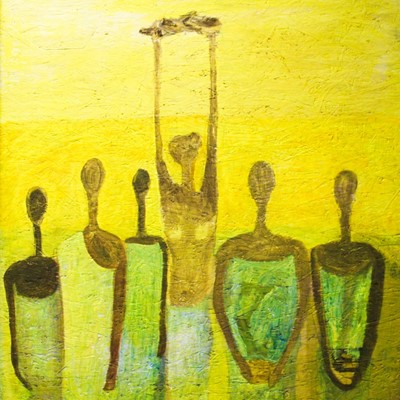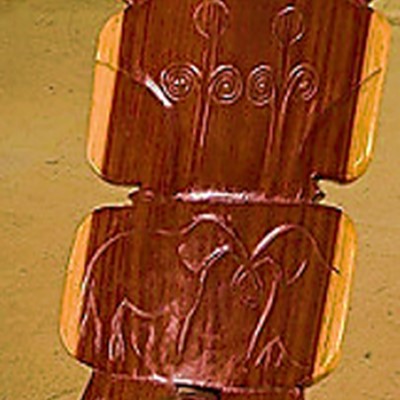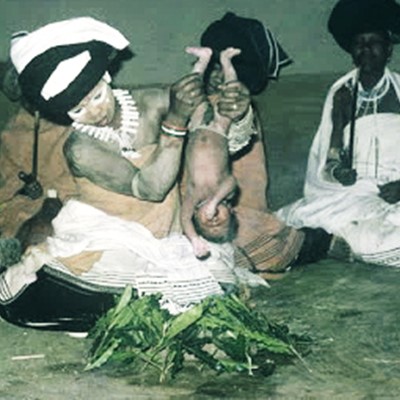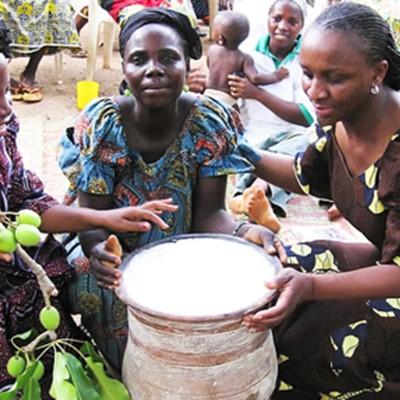Traditions around pregnancy and birth

The Samburu People
There are fewer ceremonies and traditions surrounding pregnancy amongst Christian Africans, but these remain prevalent in many African tribes, including the Samburu of Kenya. Just like the Maasai, the Samburu are a semi-nomadic people, only they remain very traditional and still follow the old customs, unlike the Maasai. Samburu custom allows women to have sexual relations with men other than their husbands; however, once pregnant, the wives may only have intercourse with their own husbands and only for the first months of pregnancy.
As the birthing time nears, the women return to the homes of their mothers or grandmothers and remain there until the child is of walking age. With the birth of a baby the woman becomes a boofeydo or ‘someone who has made an error,’ and she cannot see or speak with her husband, nor can the husband show any interest in her or the baby. After two to three years, the woman is able to visit her husband but not live with him. She may only return to her husband when her mother buys everything that is needed for her daughter’s marital home.
 Birthing Chair
Birthing Chair
Serign Sanneh, Mandinka, Gambia, on guessing the sex of the baby:
“Yes, I guess they have their own way of predicting things - if the belly’s too big it’s probably a male child and oh, they have their own way of predicting things.”
Pa Ebou Ngum, Wollof, Gambia, on guessing the sex of the baby:
“Back home there are some women, not all, who can look at your face and tell you what you’re having, yeah special people they have that qualities.”
One of the birthing practices of the Baganda in Uganda
In the Baganda group of people of Uganda there is a tradition of making banana leaf waistbands for the expectant mother, just before she was about to give birth. These would come from both the male and female banana plantations, in readiness for either sex of baby. One of them would be used to tie the baby to the mother depending on the outcome of the birth.
Nassar Lule, Baganda, Uganda:
“But still they have that one, it still continues. When you have a baby, there is a lot of tree. That one, your mum or grandpa have to bring tree leaves, and all that, and they birth you on that. That one is necessary, even if you born in the hospital. They have to bring you home. When they bring you home, the grandma is gonna be there, birth you with that one.”
Nassar Lule, Baganda, Uganda, on birth in Glasgow:
“Yeah, even here, oh, it is something that never go away. Even the people if they have baby here, they born in the hospital they talk to them over there and they say I’ll send you…(laugh), then they send it. They smash it, so it come like a powder.”
Rohay Conteh, Mandinka, Gambia, on birth in Gambia:
“Oh, yeah, yeah, mostly if you have a mum, she will help you… She will teach you how to wash the baby, how to clean the baby… Yeah, will teach you a lot of things, yeah definitely working very hard for most of the time when it comes to sleeping and stuff like that because maybe you’re too tired and need support, yeah definitely and also, yeah, how to look after yourself as well because we have medical help after people give birth and also the local traditional way that you see some people they use hot water and towel to massage the one who had the baby because also they lose a lot of blood, so they have different things they do as well like leaves and a towel to massage the mother for a few days… Some people use banana leaves, yeah banana leaves.”
Rohay Conteh, Mandinka, Gambia, on birth in Glasgow:
“Oh yeah it goes on, that’s what I’m saying. If you don’t have a banana leaf you can use a towel. It carries on here. Some people they do it for most people and it’s very helpful. And also, they tell you to tie your tummy after giving birth.”

Sifudu
Umtata tribes (in the south-eastern cape of Africa) maintain several traditions after the birth. The afterbirth is used to ‘cleanse’ the baby and is similar to ceremonies performed by several other African tribes. The umbilical cord is cut back to a length of 7-10 cm using a strip of dry grass. One hour later, the cord is again cut, this time to a length of 5cm. The remaining umbilical cord is then salved by female attendants with a preparation of ash, sugar and an egg-shaped poisonous fruit called ‘umtuma’; this is meant to rot the cord, which then drops away after three to four days.
A ceremony named ‘sifudu’ is performed between the third and fourteenth day after birth. Literally meaning ‘passing the baby through smoke’, the sifudu ceremony centres around a small fire made with pungent leaves from the sifudu tree. The leaves create an arid smoke which irritates the eyes, nose and mouth. A female attendant holds the baby upside down by its legs and passes the child through the smoke several times. The infant is then handed to its mother who is seated beside the fire; she then passes the child under one of her legs and then the other. The child is then bathed thoroughly. It is believed that the sifudu ceremony strengthens the baby, making it resistant to ridicule, fright or verbal torment.
Burying the Umbilical Cord
With the Bamiléké people of Cameroon, an important event after the birth of a child is to bury its umbilical cord under the roots of a tree. The Bamiléké have very close ties to the lands of their ancestors and to nature. If people live in the city, they will visit their ancestral lands as frequently as they possibly can due to these ties.
Jean Albert Nietcho, Bamiléké, Cameroon, on keeping up the tradition of burying the umbilical cord now that he and his family are in Glasgow:
“When you have a baby there is one that…the ceremony that you have to do….one of the most important ceremony. The umbilical cord….because the umbilical cord is very, very significant for us. You have to….you bury…you bury your umbilical cord where your ancestor came from. Even my kid’s one. I keep it from the hospital. I keep it and when I go back home, I will bury it where our ancestors came from. We do believe that is a link to where we came from… What we do here is when we have a baby. I will call it baby seeing. So, you do, you invite people. They call it in French vois bébé. So, we do it here.”
Lydie Bere Flere Dossa, Akan, Ivory Coast, on pregnancy and birth in Glasgow:
“Yeah, in Glasgow, yes, the African community…. Because, it’s not only people from Ivory Coast. Because when you emerge in another country, you know other African People, as well, because I have friends from all over the world. From Congo, from Cameroon, from Benin. I have them from Eritrea. I have them from Egypt. I have them from America. I have Scottish friend. Beautiful Scottish friend, families, you know. I have them from France, Germany, Italy, all over. You are like friend. There is friend and there is close friend and there is family. You know, because I have some Scottish family who are like family. You do things together, you travel together, with our children, so that you are like family. So, people like this they gave me food, they was cooking for me, you know, for my child, for me. They came and visit me. They bring me gift… So, I told the health visitor, no, I have people to look after me. But she asked me, she asked to bring help to go and do my shopping. I said, no, I have people to look after me. But she asked me, she asked to bring help, to go and do my shopping. I said, no, I have people around me, so, I feel fine. So, the same way that in Africa, people are around you when you give birth. Here, as well, I think so, I think there’s people around you to give you help.”
 Shea Butter
Shea Butter
Shea Butter
One of our Akan respondents, originally from what is now the Ivory Coast, told us about the tradition amongst new mothers of using the lovely smell and skin enhancing properties of shea butter to show that they are doing well and are in good health after the birth. Shea butter has been known for centuries as ‘women's gold’ in Africa, as it is a product which has been primarily made by women for women. They extract the product from the karité nuts (which grow in the Sahel region that stretches from West to East Africa, from Guinea and Senegal to Uganda and South Sudan), and it is then used locally and in the cosmetic and food industries.
Next page: Naming Ceremonies